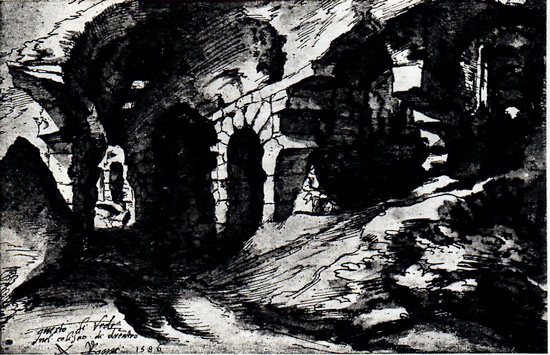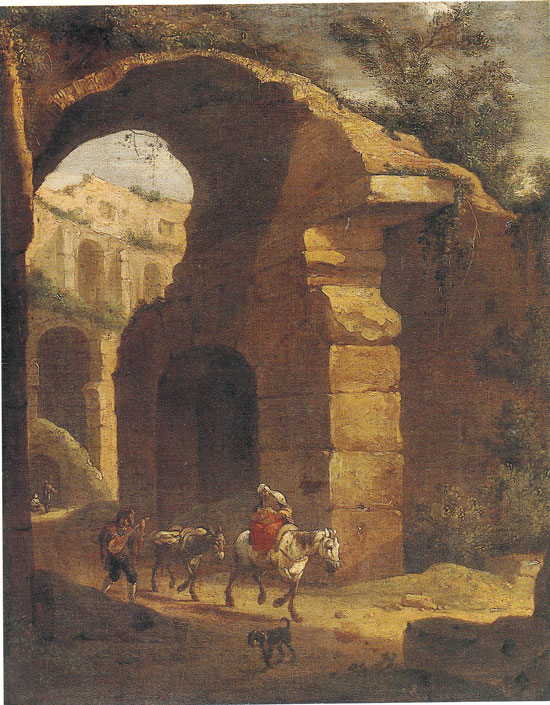
- Home Page
- Accepted
Paintings & Copies - Doubtful
Attributions - Doubtful Textual References
- Alternative
Titles - Collectors &
Museums - Bibliography
- Search Abecedario
- Watteau &
His Circle
La Ruine
Entered February 2020

Presumed lost
Oil on canvas
97.2 x 129.6 cm
ALTERNATIVE TITLES
Paysage orné de ruines
RELATED PRINTS
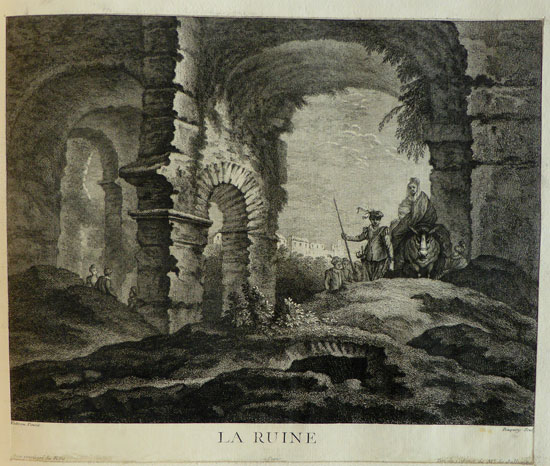
Watteau’s La Ruine was engraved by Maurice Baquoy prior to 1737, probably in the reverse direction of the painting.
PROVENANCE
Paris, collection of Jean de Jullienne (1686-1766; director of a tapestry factory) Jullienne’s ownership of the painting is cited on the engraving: ”Tiré du Cabinet de Mr de Jullienne.” The picture was no longer with Jullienne by 1756 when a manuscript inventory of his collection was drawn up; now in the Morgan Library & Museum, New York.
Paris, collection of Antoine Joseph d’Eslacs, marquis de Arcambal (1727-1789; military officer). His sale, Paris, February 22ff, 1776, lot 83: “Antoine Vatteau . . . Un Paysage chaud de couleur, & saisi à l’effet du Soleil couchant: sur un terrein élevé se voient les ruine d’un Temple, & plus loin, dans le fond, un Village entouré de montagnes, & bordé d’une riviere; & sur le devant, quelques Figures de Pelerins se tenant sous les bras, & prêts à passer dans un chemin de roches: hauteur trente-six pouces, largeur quarante-huit. T.” Sold for 364 livres.
SELECT BIBLIOGRAPHY
Hédouin, “Watteau” (1845), cat. 53.
Hédouin, Mosaïque (1856), cat. 54.
Goncourt, L’Art au XVIIIème siècle (1860), 58.
Goncourt, Catalogue raisonné (1875), cat. 193.
Réau, “Watteau” (1928), cat. 200.
Dacier, Vuaflart, and Hérold, Jean de Jullienne et les graveurs (1921-29), cat. 171.
Adhémar, Watteau (1950), cat. 49.Macchia and Montagni, L’opera completa di Watteau (1969), cat. 60.
Ferré, Watteau (1972), cat. B70.
Roland Michel, Watteau (1981), cat. 132.
Eidelberg “Watteau’s Italian Reveries” (1995), 122-23.
Michel, Le «célèbre Watteau» (2008), 108.
Eidelberg, Rêveries italiennes (2015), 37-39.
RELATED DRAWINGS
No known drawings are associated with La Ruine.
REMARKS
Our suggested provenance from the d’Arcambal collection is provisional. Certainly the description of that painting corresponds to what we see in Baquoy’s print: the foreground, on a rise in the land, pilgrims pass through on a rocky road under the ruins of a temple. The sale catalogue also informs us of something that we cannot perceive from the engraving, namely that the sky was akin to a sunset, i.e., with pink clouds and glowing light, the sort of sky that one finds in other Watteau landscapes.
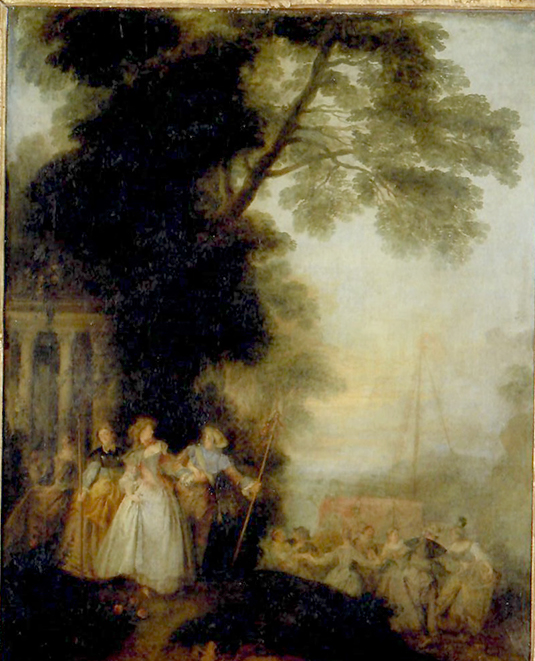
Nicolas Lancret, The Departure for the Island of Cythera, c. 1720, oil on canvas, 73.5 x 60 cm. Berlin, Stiftung Preussische Schlösser und Gärten.
The painting’s whereabouts after the d’Arcambal sale in 17776 are not known. Some have pointed to another landscape attributed to Watteau, also depicting pilgrims and ruins, that appeared at auction in Paris only a few years later, on May 15, 1786:
Un Paysage orné de ruines & masses d'arbres, sur le devant duquel on voit plusieurs jeunes Filles, accompagnées de Pélerins. Ce Tableau est fait avec facilité par le même. Hauteur 3 pieds, largeur 3 pieds 8 pouces 6 lignes. T.
While essentially the same scale as d’Arcambal’s painting, the mention of several female and male pilgrims in the foreground suggests that it was a very different composition. It could even have been like Lancret’s Pilgrimage to Cythera in Berlin, although that painting does not depict ruins, just a portion of a classical temple.
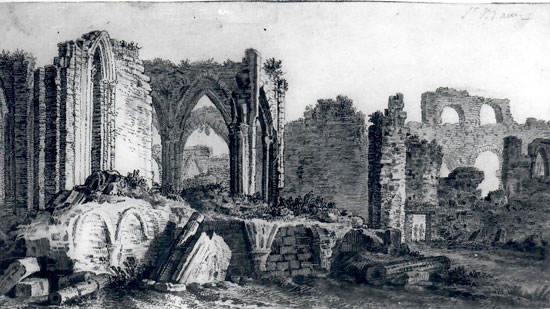
Anonymous French artist, View of the Ruins of the Abbey of Saint-Maur-des-Fossés, pen and ink, wash.Paris, Bibliothèque nationale.
La Ruine stands out in Watteau’s oeuvre because of the dominance given the ruined building. Indeed, it led to the title that Jullienne gave it. Dacier and Vuaflart proposed that the picture showed the ruins of the Abbey of Saint-Maur-des-Fossés, a monument recorded in an anonymous drawing in the Bibliothèque nationale. They also noted that that site was near Nogent-sur-Marne but, curiously, they drew no conclusion, although Watteau spent his last days in Nogent. Macchia and Montagni wrongly claimed that Saint-Maur was near a house owned by Crozat. Although the ruins of Saint-Maur have frequently been associated with La Ruine, it would seem that none of these critics actually saw the drawing in question. Had they looked at it, they would have noted that the abbey was in the Gothic style whereas the architectural fragments depicted by Watteau are clearly Roman.
The complex, monumental vaults, classical moldings, and uneven terrain establish that the site that Watteau painted was the ruins of the Colosseum in Rome. Although Watteau never traveled to Italy as he had hoped to do, he had access to drawings by French and Dutch seventeenth- and eighteenth-century artists who had made the trip. The Colosseum impressed so many visiting artists that it was almost obligatory to record the site. Moreover, pictures like Thomas Wyck’s remind us that such Roman monuments were often the subjects of paintings. In short, both visual data and artistic precedence would have guided him in painting La Ruine.
The Italian subject of La Ruine links this painting with several others that similarly depict famous Roman sites: La Promenade sur les remparts shows the Campo vaccino and Farnese gardens; La Mariée de village depicts Vignola’s church of Sant’Andrea del via Flaminia; and La Chute d’eau features the great water fall at Tivoli. These paintings, seemingly painted within a short span of time, are generally dated between 1710 and 1715. Adhémar placed La Ruine in 1710-11, as did Macchia and Montagni, while Roland Michel questioningly proposed a date of c. 1714.
